Grey Wolf Optimization-Based Optimum Energy-Management and Battery-Sizing Method for Grid-Connected Microgrids
Abstract
:1. Introduction
2. Mathematical Problem Formulation
2.1. Objective Function
2.2. Constraints
2.2.1. Balance of Electrical Load Demands
2.2.2. Boundaries of Distributed Generation (DG) Constraints
2.2.3. Grid Constraints
2.2.4. Operation Reserve (OR) Constraints
2.2.5. Battery Energy Storage (BES) Constraints
3. Grey Wolf Optimizer (GWO)
Mathematical Formulation of GWO
| Algorithm 1 GWO pseudo-code |
| Initialize the locations of the grey wolf population Xi (i = 1, 2, …, n Initialize a, A and C Calculate the objective function value for each grey wolf agent Set: Xα as best result of the search agents Xβ as the second best result of the search agents Xδ as the third best result of the search agents While (t < max number of iteration) the termination criterion is not satisfied do Initialize r1 and r2 values Update a by Equation (30) Update A by Equation (28) Update C by Equation (29) For i For j Update the positions of each grey wolf agent by using Equations (31)–(37) End j End i Calculate the fitness of all agents with the new positions t = t + 1 End while return Xα |
4. The GWO Implementation of the Optimal Operation Management of the Microgrid
| Algorithm 2 Function handle |
| For t = 1 to NT do For m = 1 to NOA do Part 1: power balance and generation source capacity handling Calculate the power difference between the generation sources and load demand Pdiff = (P_MT,t u_MT,t + P_FC,t u_FC,t + P_PV,t + P_WT,t + P_BES,t u_BES,t + P_grid,) − PD,t; Select random generation sources based on their capacity While P_diff ≠ 0 do Subtract P_diffm,t from the selected units Check the capabilities of the generation units based on lower and upper limits as follows: If Pm,FC,t < PFC,min then Pm,FC, = PFC,min; or Pm,MT,t < PMT,min then Pm,MT,t = PMT,min; or Pm,grid,t < Pgrid,min then Pm,grid,t = Pgrid,min; or Pm,BES,t < PBES,min then Pm,BES,t = PBES,min; Elseif Pm,FC,t > PFC,max then Pm,FC, = PFC,max; or Pm,MT,t > PMT,max then Pm,MT,t = PMT,max; or Pm,grid,t > Pgrid,max then Pm,grid,t = Pgrid,max; or Pm,BES,t < PBES,max then Pm,BES,t = PBES,max; End if Calculate P_diffm,t Select another generation units randomly End while Part 2: ORs handling Calculate objective function (ft) by using Equation (2) If P_MT,t u_MT,t + P_FC,t u_FC,t + P_PV,t + P_WT,t + P_BES,t u_BES,t + P_grid,t < PD,t + ORt Then ft = ft + Penalty_Factor ×(P_MT,t u_MT,t + P_FC,t u_FC,t + P_PV,t + P_WT,t + P_BES,t u_BES,t + P_grid,t – (PD,t + ORt)) End if End for m Calculate Equation (1) End for t |


5. Numerical Results and Discussion
Description of the Microgrid Test System and the Data Inputs
- Scenario A: The microgrid operates without BES.
- Scenario B: The microgrid’s BES does not have an initial value (uncharged).
- Scenario C: The microgrid’s BES has an initial value equal to its size (fully charged).
Scenario A
Scenario B
Scenario C
6. Conclusions
Author Contributions
Conflicts of Interest
Nomenclature
| Indices | |
| ADNs | Active distribution networks |
| ASO | Adaptive storage operation |
| BA | Bat algorithm |
| BBO | Biogeography- based optimisation |
| BES, grid | Battery energy storage and grid indices, respectively |
| BESS | Battery energy storage system |
| DE | Differential evolution |
| DG | Distribution generation |
| DP | Dynamic programming |
| ESS | Energy storage system |
| FC, MT | Fuel cell and micro-turbine indices, respectively |
| GA | Genetic algorithm |
| GHG | Greenhouse gas |
| GWO | Grey wolf optimizer |
| HBB-BC | Hybrid big bang–big crunch |
| t | time index |
| T | Operation time horizon (h) |
| TLBO | Teaching-learning based optimisation |
| TPC | Total present cost |
| TS | Tabu search |
| iter | iteration index of the GWO algorithm |
| MAS | Multi-agent system |
| MGCC | Microgrid central controller |
| MILP | Mixed-integer linear programming |
| NOA | Number of agents |
| PSO | Particle swarm optimization |
| PV, WT | Photovoltaic and wind turbine indices, respectively |
| SD | Storages devices |
| SDO | Simulink design optimization |
| IBA | Improved bat algorithm |
| IR | Interest rate for financing the installed BES |
| RES | Renewable sources |
| Constants | |
| Bgrid,t, BBES,t, BMT,t, BFC,t, BPV,t, BWT,t | Bid of utility, BES, MT, FC, PV and WT, respectively, at time t (€ct/kWh). |
| CBES,min, CBES,max | Minimum and maximum size of BES (kWh) |
| CSD_Max | Maximum capacity of storage device |
| CSD_Min | Minimum capacity of storage devices |
| FCBES, MCBES | Fixed and maintenance cost for BES, respectively (€ct/kWh) |
| Iter_max | Maximum number of iteration for the GWO algorithm |
| LT | Lifetime of the installed BES (year) |
| OMDG | Fixed operation and maintenance cost of distributed generators (DGs; €ct) |
| OMMT, OMFC OMPV, OMWT | Fixed operation and maintenance cost of MT, FC, PV and WT, respectively (€ct/kWh) |
| ORt | Minutes operating reserve requirements (kW) |
| PBESmax,t PBESmin,t | Maximum discharge and charge rates of BES, respectively, at time t (kW) |
| ηd, ηc | Discharge and charge efficiencies of BES, respectively |
| SDCMT,t, SDCFC,t | Shutdown cost for MT and FC, respectively, at time t (€ct) |
| SDMT, SDFC | Shutdown cost coefficient for MT and FC, respectively (€ct) |
| SUCMT,t, SUCFC,t | Startup cost for MT and FC, respectively, at time t (€ct) |
| SUMT, SUFC | Startup cost coefficient for MT and FC, respectively (€ct) |
| tax | Tax rate of utility power grid |
| Δt | Time interval duration |
| Pgrid,max, Pgrid,min | Maximum/minimum limits of power production for utility, respectively (kW) |
| PMT,max, PFC,max, PPV,tmax, PWT,t max, PBES,max | Maximum producible power of MT, FC, PV, WT and BES respectively (kW) |
| PMT,min, PFC,min, PPV,tmin, PWT,t min, PBES,min | Minimum producible power of MT, FC, PV, WT and BES respectively (kW) |
| PSD_Max | Maximum power of storage device |
| Variables | |
| CostDG,t, CostBES,t | Cost of fuel and operating power of DGs and BES, respectively, at time t (€ct) |
| F | Total costs (€ct) |
| Pgrid,t, PBES,t, PMT,t, PFC,t PPV,t, PWT, t | Power of utility, BES, MT, FC, PV, and WT, respectively (kW) |
| PSD_min | Minimum power of storage device |
| TCPDBES | Total cost per day of BES (€ct) |
| Up | Utility price |
| X | Position vector of a grey wolf in GWO algorithm |
| XP | Position vector of the prey in GWO algorithm |
| Gp | Gas price |
| Costgrid,t | Cost of trade with the upstream grid at time t (€ct) |
| CSD_Max | Maximum capacity of storage device |
| PD,t | Electrical load demand at time t (kW) |
| CBES,t | Energy stored in BES at time t (kWh) |
| uBES,t, uMT,t, uFC,t | Status (on or off) of BES, MT, and FC, respectively, at time t |
| Sg | Dispatch of storage device |
Appendix A
| Method | Method Mode | Generation SOURCE | Analysis | Objective Function | CONSTRAINTS | Ref. | ||||||||
|---|---|---|---|---|---|---|---|---|---|---|---|---|---|---|
| Single | Hybrid | PV | WT | DG | FC | MT | HB | Wave | SD | |||||
| Adaptive Storage Operation | √ | √ | √ | √ | √ | Techno-Economic | Forecast accuracy | Energy balance | [7] | |||||
| PSCAD/EMTDC Software | √ | √ | √ | √ | √ | √ | Techno | Primary frequency control | Overloading characteristics and limitations of the state of charge (SOC) of SD | [8] | ||||
| Mixed Integer Linear Programming | √ | √ | √ | Economic | Microgrid operation cost | Non-linear loads | [9] | |||||||
| √ | √ | √ | √ | √ | Economic | Minimization of the levelized cost of energy (LCOE) | Renewable sources intermittency | [10] | ||||||
| √ | √ | √ | √ | √ | Techno-Economic | Optimal design of standalone microgrid | Uncertainty of the generation sources | [11] | ||||||
| √ | √ | √ | √ | √ | √ | Economic | Optimal size of storage device based on cost-benefit | Unit commitment problem with spinning reserve of microgrid | [12] | |||||
| √ | √ | Economic | Minimizes the annualized investment and operation costs | Optimal type, size and allocation of distributed generators in radial distribution system | [13] | |||||||||
| √ | √ | Techno-Economic | Non-convex economic dispatch (ED) | Ramp rate constraints, valve-point effect (VPE), prohibited operating zones (POZs), transmission loss, and spinning reserve constraints. | [14] | |||||||||
| Linear Programing | √ | √ | √ | √ | √ | Techno-Economic | Maximizing the economic and minimize the annual cost | energy prices, ambient conditions, energy demand, units’ characteristics, electricity grid constraints | [15] | |||||
| Cuckoo Search | √ | √ | √ | √ | Economic | Minimize the operational costs | System reliability | [16] | ||||||
| Inventory Models | √ | √ | √ | Economic | Minimize the operational costs | Energy source cost and availability | [17] | |||||||
| Self-Adaptive Mutation Strategy | √ | √ | √ | √ | √ | √ | Economic | Cost minimization | Ramp rate of generation sources | [18] | ||||
| Distributed Economic Model Predictive Control | √ | √ | √ | Economic | Cost minimization | System stability | [19] | |||||||
| Multi-Objective Evolutionary Algorithm | √ | √ | √ | Techno-Economic | Decreasing switching operation | System stability | [20] | |||||||
| Dynamic Programming Algorithm | √ | √ | √ | √ | Techno-Economic | Maximize the power rating | Reliability and system efficiency | [21] | ||||||
| Self-Adaptive Dynamic Programming | √ | √ | √ | Economic | Cost minimization | System stability | [22] | |||||||
| Genetic Algorithm | √ | √ | √ | √ | Techno-Economic | Maximize the power rating | System stability | [23] | ||||||
| √ | √ | √ | √ | √ | Economic | minimization of life-cycle cost of the generation sources | Limitation of battery state of charge | [24] | ||||||
| Particle Swarm Optimization | √ | √ | √ | √ | Techno-Economic | Cost minimization | System stability | [25] | ||||||
| √ | √ | √ | √ | Techno-Economic | Improve system stability and performance | System frequency control | [26] | |||||||
| Particle Swarm–Nelder–Mead | √ | √ | Techno-Economic | Cost minimization | System stability | [27] | ||||||||
| Big Bang–Big Crunch algorithm | √ | √ | √ | √ | Economic | Cost minimization | System reliability | [28] | ||||||
| Non-Linear Programming Optimization | √ | √ | √ | √ | Economic | Maximize the revenues of the renewable farm | System stability | [29] | ||||||
| Alternating Direction Method of Multipliers | √ | √ | √ | √ | Techno-Economic | Minimize network losses and energy cost | Network voltage limitation | [30] | ||||||
| Differential Evolution algorithm | √ | √ | √ | √ | Techno-Economic | Reducing power losses, improving voltage stability of the system and reducing charging costs | Network voltage limitation | [31] | ||||||
| Fuzzy Logic–Genetic Algorithm | √ | √ | √ | Economic | Predicting storage device lifetime and minimize the costs | Unit commitment problem | [32] | |||||||
| Photovoltaic-Trigeneration Optimization Model | √ | √ | √ | Economic | Minimize operational costs and emissions | Renewable sources intermittency | [33] | |||||||
| Simulink Design Optimization | √ | √ | √ | √ | Economic | Cost minimization | Renewable sources intermittency | [34] | ||||||
| Fuzzy Logic–Particle Swarm Optimization | √ | √ | √ | √ | √ | Economic | Minimize operational costs and emissions | System stability | [35] | |||||
| Fuzzy Logic–Multi Agent System | √ | √ | √ | √ | √ | Economic | Cost minimization | System stability | [36] | |||||
References
- Nosratabadi, S.M.; Hooshmand, R.-A.; Gholipour, E. A comprehensive review on microgrid and virtual power plant concepts employed for distributed energy resources scheduling in power systems. Renew. Sustain. Energy Rev. 2017, 67, 341–363. [Google Scholar] [CrossRef]
- Al-Falahi, M.D.; Jayasinghe, S.; Enshaei, H. A review on recent size optimization methodologies for standalone solar and wind hybrid renewable energy system. Energy Convers. Manag. 2017, 143, 252–274. [Google Scholar] [CrossRef]
- Bahmani-Firouzi, B.; Azizipanah-Abarghooee, R. Optimal sizing of battery energy storage for micro-grid operation management using a new improved bat algorithm. Int. J. Electr. Power Energy Syst. 2014, 56, 42–54. [Google Scholar] [CrossRef]
- Al-Falahi, M.D.; Wanik, M.Z.C. Modeling and Performance Analysis of Hybrid Power System for Residential Application. In Proceedings of the 2015 Australasian Universities Power Engineering Conference (AUPEC), Wollongong, Australia, 27–30 September 2015; pp. 1–6. [Google Scholar]
- Al-Falahi, M.D.; Nimma, K.S.; Jayasinghe, S.; Enshaei, H. Sizing and Modeling of a Standalone Hybrid Renewable Energy System. In Proceedings of the IEEE Annual Southern Power Electronics Conference (SPEC), Auckland, New Zealand, 5–8 December 2016; pp. 1–6. [Google Scholar]
- Geem, Z.W.; Yoon, Y. Harmony search optimization of renewable energy charging with energy storage system. Int. J. Electr. Power Energy Syst. 2017, 86, 120–126. [Google Scholar] [CrossRef]
- Bridier, L.; Hernández-Torres, D.; David, M.; Lauret, P. A heuristic approach for optimal sizing of ESS coupled with intermittent renewable sources systems. Renew. Energy 2016, 91, 155–165. [Google Scholar] [CrossRef]
- Aghamohammadi, M.R.; Abdolahinia, H. A new approach for optimal sizing of battery energy storage system for primary frequency control of islanded microgrid. Int. J. Electr. Power Energy Syst. 2014, 54, 325–333. [Google Scholar] [CrossRef]
- Rigo-Mariani, R.; Sareni, B.; Roboam, X. Fast power flow scheduling and sensitivity analysis for sizing a microgrid with storage. Math. Comput. Simul. 2017, 131, 114–127. [Google Scholar] [CrossRef]
- Malheiro, A.; Castro, P.M.; Lima, R.M.; Estanqueiro, A. Integrated sizing and scheduling of wind/PV/diesel/battery isolated systems. Renew. Energy 2015, 83, 646–657. [Google Scholar] [CrossRef]
- Billionnet, A.; Costa, M.-C.; Poirion, P.-L. Robust optimal sizing of a hybrid energy stand-alone system. Eur. J. Oper. Res. 2016, 254, 565–575. [Google Scholar] [CrossRef]
- Chen, S.; Gooi, H.B.; Wang, M. Sizing of energy storage for microgrids. IEEE Trans. Smart Grid 2012, 3, 142–151. [Google Scholar] [CrossRef]
- Rueda-Medina, A.C.; Franco, J.F.; Rider, M.J.; Padilha-Feltrin, A.; Romero, R. A mixed-integer linear programming approach for optimal type, size and allocation of distributed generation in radial distribution systems. Electr. Power Syst. Res. 2013, 97, 133–143. [Google Scholar] [CrossRef]
- Wu, Z.L.; Ding, J.Y.; Wu, Q.H.; Jing, Z.X.; Zhou, X.X. Two-phase mixed integer programming for non-convex economic dispatch problem with spinning reserve constraints. Electr. Power Syst. Res. 2016, 140, 653–662. [Google Scholar] [CrossRef]
- Brandoni, C.; Renzi, M. Optimal sizing of hybrid solar micro-CHP systems for the household sector. Appl. Therm. Eng. 2015, 75, 896–907. [Google Scholar] [CrossRef]
- Sanajaoba, S.; Fernandez, E. Maiden application of Cuckoo Search algorithm for optimal sizing of a remote hybrid renewable energy System. Renew. Energy 2016, 96, 1–10. [Google Scholar] [CrossRef]
- Schneider, M.; Biel, K.; Pfaller, S.; Schaede, H.; Rinderknecht, S.; Glock, C.H. Optimal sizing of electrical energy storage systems using inventory models. Energy Procedia 2015, 73, 48–58. [Google Scholar] [CrossRef]
- Mohammadi, S.; Mohammadi, A. Stochastic scenario-based model and investigating size of battery energy storage and thermal energy storage for micro-grid. Int. J. Electr. Power Energy Syst. 2014, 61, 531–546. [Google Scholar] [CrossRef]
- Zhang, X.; Bao, J.; Wang, R.; Zheng, C.; Skyllas-Kazacos, M. Dissipativity based distributed economic model predictive control for residential microgrids with renewable energy generation and battery energy storage. Renew. Energy 2017, 100, 18–34. [Google Scholar] [CrossRef]
- Camillo, M.H.M.; Fanucchi, R.Z.; Romero, M.E.V.; de Lima, T.W.; Soares, A.D.; Delbem, A.C.B.; Marques, L.T.; Maciel, C.D.; Junior, J.B.A.L. L. Combining exhaustive search and multi-objective evolutionary algorithm for service restoration in large-scale distribution systems. Electr. Power Syst. Res. 2016, 134, 1–8. [Google Scholar] [CrossRef]
- Nguyen, T.A.; Crow, M.L.; Elmore, A.C. Optimal sizing of a Vanadium Redox battery system for microgrid systems. IEEE Trans. Sustain. Energy 2015, 6, 729–737. [Google Scholar] [CrossRef]
- Rigo-Mariani, R.; Sareni, B.; Roboam, X.; Turpin, C. Optimal power dispatching strategies in smart-microgrids with storage. Renew. Sustain. Energy Rev. 2014, 40, 649–658. [Google Scholar] [CrossRef] [Green Version]
- Mohammadi, M.; Hosseinian, S.; Gharehpetian, G. GA-based optimal sizing of microgrid and DG units under pool and hybrid electricity markets. Int. J. Electr. Power Energy Syst. 2012, 35, 83–92. [Google Scholar] [CrossRef]
- Zhao, B.; Zhang, X.; Li, P.; Wang, K.; Xue, M.; Wang, C. Optimal sizing, operating strategy and operational experience of a stand-alone microgrid on Dongfushan Island. Appl. Energy 2014, 113, 1656–1666. [Google Scholar] [CrossRef]
- Kerdphol, T.; Fuji, K.; Mitani, Y.; Watanabe, M.; Qudaih, Y. Optimization of a battery energy storage system using particle swarm optimization for stand-alone microgrids. Int. J. Electr. Power Energy Syst. 2016, 81, 32–39. [Google Scholar] [CrossRef]
- Kerdphol, T.; Qudaih, Y.; Mitani, Y. Optimum battery energy storage system using PSO considering dynamic demand response for microgrids. Int. J. Electr. Power Energy Syst. 2016, 83, 58–66. [Google Scholar] [CrossRef]
- Mesbahi, T.; Khenfri, F.; Rizoug, N.; Chaaban, K.; Bartholomeüs, P.; le Moigne, P. Dynamical modeling of Li-ion batteries for electric vehicle applications based on hybrid Particle Swarm–Nelder–Mead (PSO–NM) optimization algorithm. Electr. Power Syst. Res. 2016, 131, 195–204. [Google Scholar] [CrossRef]
- Ahmadi, S.; Abdi, S. Application of the Hybrid Big Bang–Big Crunch algorithm for optimal sizing of a stand-alone hybrid PV/wind/battery system. Solar Energy 2016, 134, 366–374. [Google Scholar] [CrossRef]
- Berrada, A.; Loudiyi, K. Operation, sizing, and economic evaluation of storage for solar and wind power plants. Renew. Sustain. Energy Rev. 2016, 59, 1117–1129. [Google Scholar] [CrossRef]
- Nick, M.; Cherkaoui, R.; Paolone, M. Optimal siting and sizing of distributed energy storage systems via alternating direction method of multipliers. Int. J. Electr. Power Energy Syst. 2015, 72, 33–39. [Google Scholar] [CrossRef]
- Moradi, M.H.; Abedini, M.; Tousi, S.R.; Hosseinian, S.M. Optimal siting and sizing of renewable energy sources and charging stations simultaneously based on Differential Evolution algorithm. Int. J. Electr. Power Energy Syst. 2015, 73, 1015–1024. [Google Scholar] [CrossRef]
- Fossati, J.P.; Galarza, A.; Martín-Villate, A.; Fontán, L. A method for optimal sizing energy storage systems for microgrids. Renew. Energy 2015, 77, 539–549. [Google Scholar] [CrossRef]
- Nosrat, A.H.; Swan, L.G.; Pearce, J.M. Simulations of greenhouse gas emission reductions from low-cost hybrid solar photovoltaic and cogeneration systems for new communities. Sustain. Energy Technol. Assess. 2014, 8, 34–41. [Google Scholar] [CrossRef]
- Castañeda, M.; Cano, A.; Jurado, F.; Sanchez, H.; Fernandez, L.M. Sizing optimization, dynamic modeling and energy management strategies of a stand-alone PV/hydrogen/battery-based hybrid system. Int. J. Hydrogen Energy 2013, 38, 3830–3845. [Google Scholar] [CrossRef]
- Mahmoud, T.S.; Habibi, D.; Bass, O. Fuzzy Logic for Smart Utilisation of Storage Devices in a Typical Microgrid. In Proceedings of the 2012 International Conference on Renewable Energy Research and Applications (ICRERA), Nagasaki, Japan, 11–14 November 2012; pp. 1–6. [Google Scholar]
- Mahmoud, T.S.; Habibi, D.; Bass, O. Fuzzy-Based Adaptive Pricing Rules for a Typical Microgrid Energy Management system. In Proceedings of the 9th IET International Conference on Advances in Power System Control, Operation and Management (APSCOM 2012), Hong Kong, China, 18–21 November 2012; pp. 1–6. [Google Scholar]
- Mirjalili, S.; Mirjalili, S.M.; Lewis, A. Grey wolf optimizer. Adv. Eng. Softw. 2014, 69, 46–61. [Google Scholar] [CrossRef]
- Kamboj, V.K.; Bath, S.; Dhillon, J. Solution of non-convex economic load dispatch problem using Grey Wolf Optimizer. Neural Comput. Appl. 2016, 27, 1301–1316. [Google Scholar] [CrossRef]
- Sheng, W.; Liu, K.-Y.; Meng, X.; Ye, X.; Liu, Y. Research and practice on typical modes and optimal allocation method for PV-Wind-ES in microgrid. Electr. Power Syst. Res. 2015, 120, 242–255. [Google Scholar] [CrossRef]
- Moghaddam, A.A.; Seifi, A.; Niknam, T. Multi-operation management of a typical micro-grids using Particle Swarm Optimization: A comparative study. Renew. Sustain. Energy Rev. 2012, 16, 1268–1281. [Google Scholar] [CrossRef]
- DiOrio, N.; Dobos, A.; Janzou, S.; Nelson, A.; Lundstrom, B. Technoeconomic Modeling of Battery Energy Storage in SAM; National Renewable Energy Laboratory, Golden. Golden, CO, USA, 2015. [Google Scholar]
- Feng, X.; Gooi, H.B.; Chen, S. Capacity fade-based energy management for lithium-ion batteries used in PV systems. Electr. Power Syst. Res. 2015, 129, 150–159. [Google Scholar] [CrossRef]

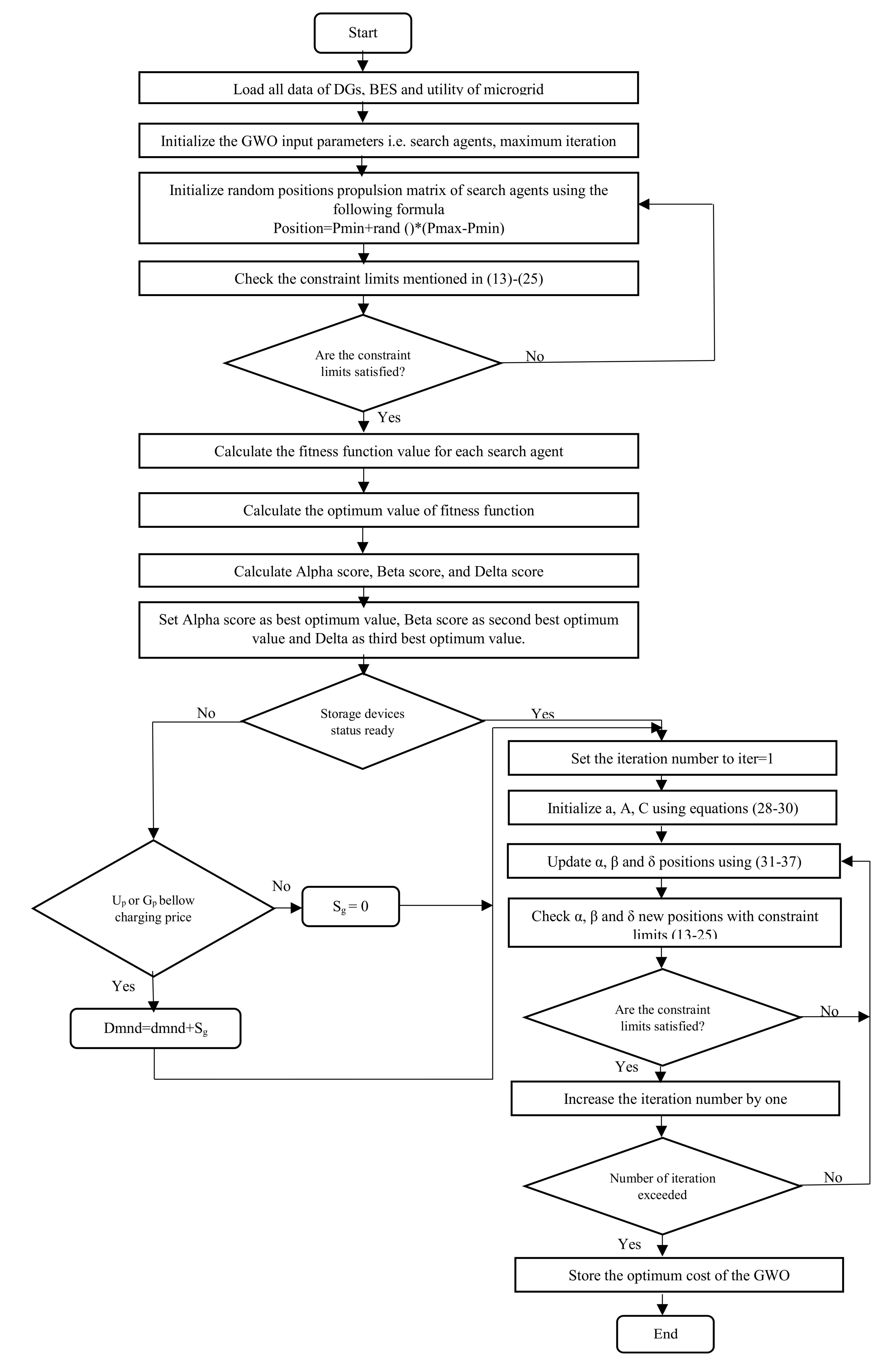

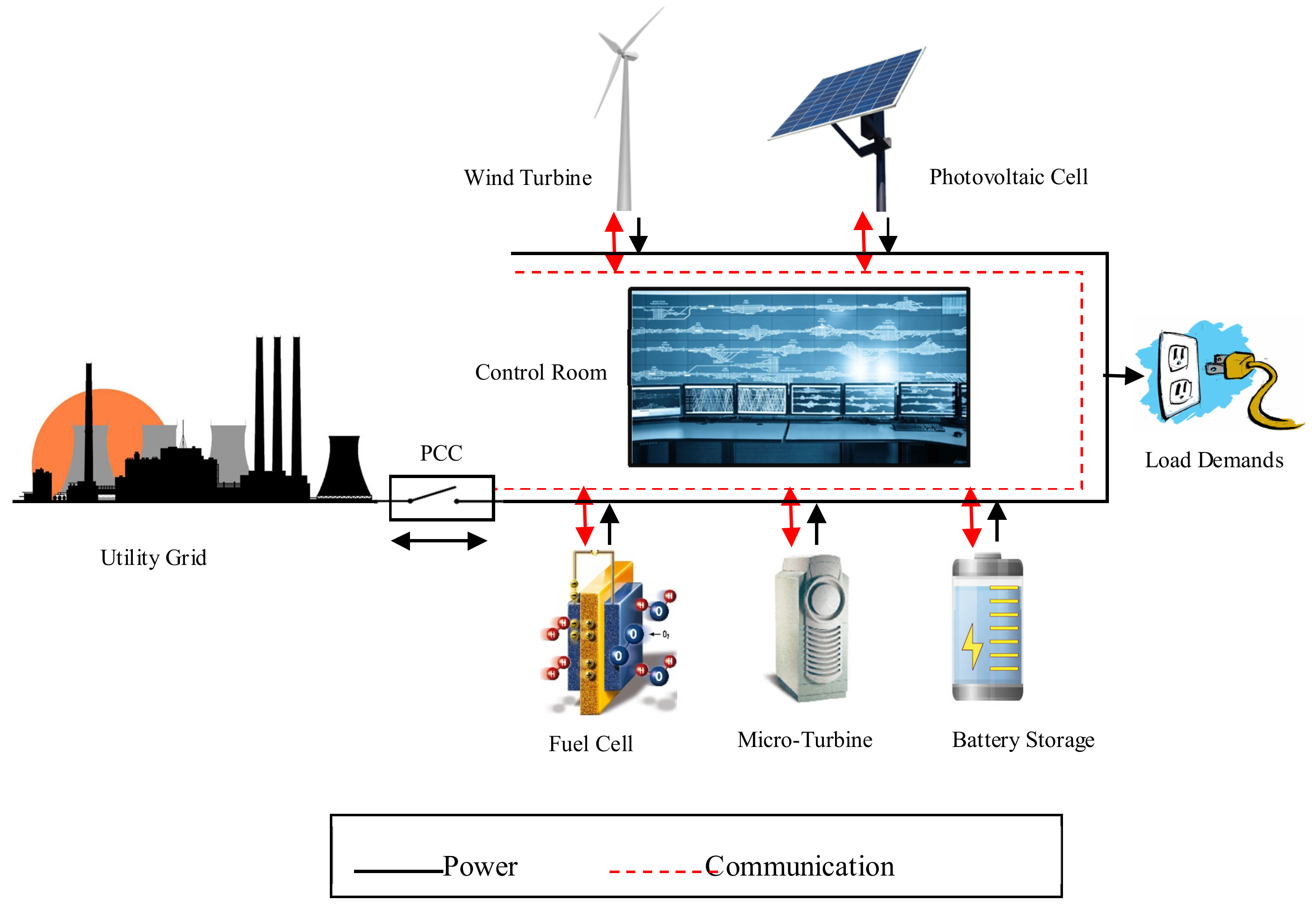
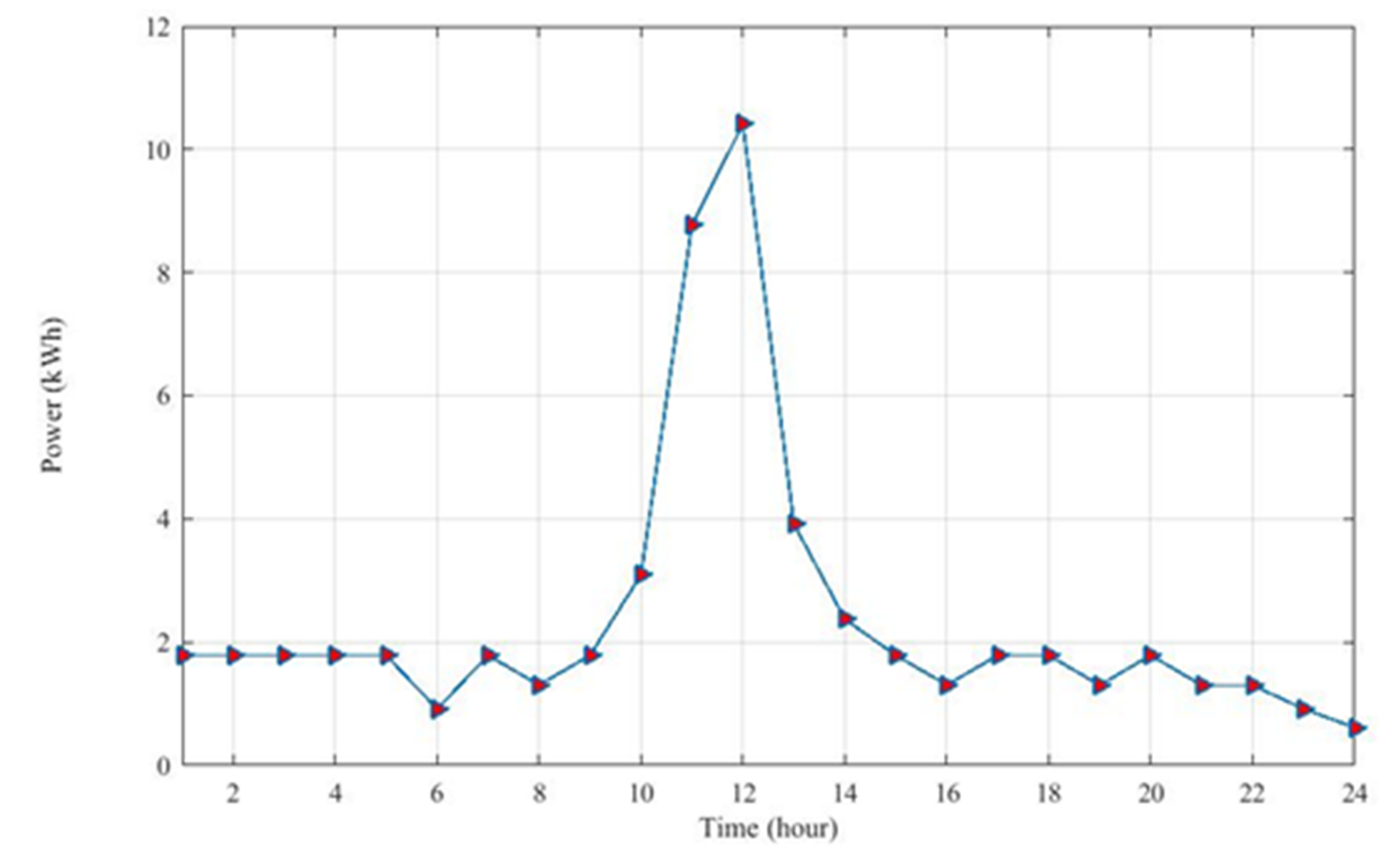

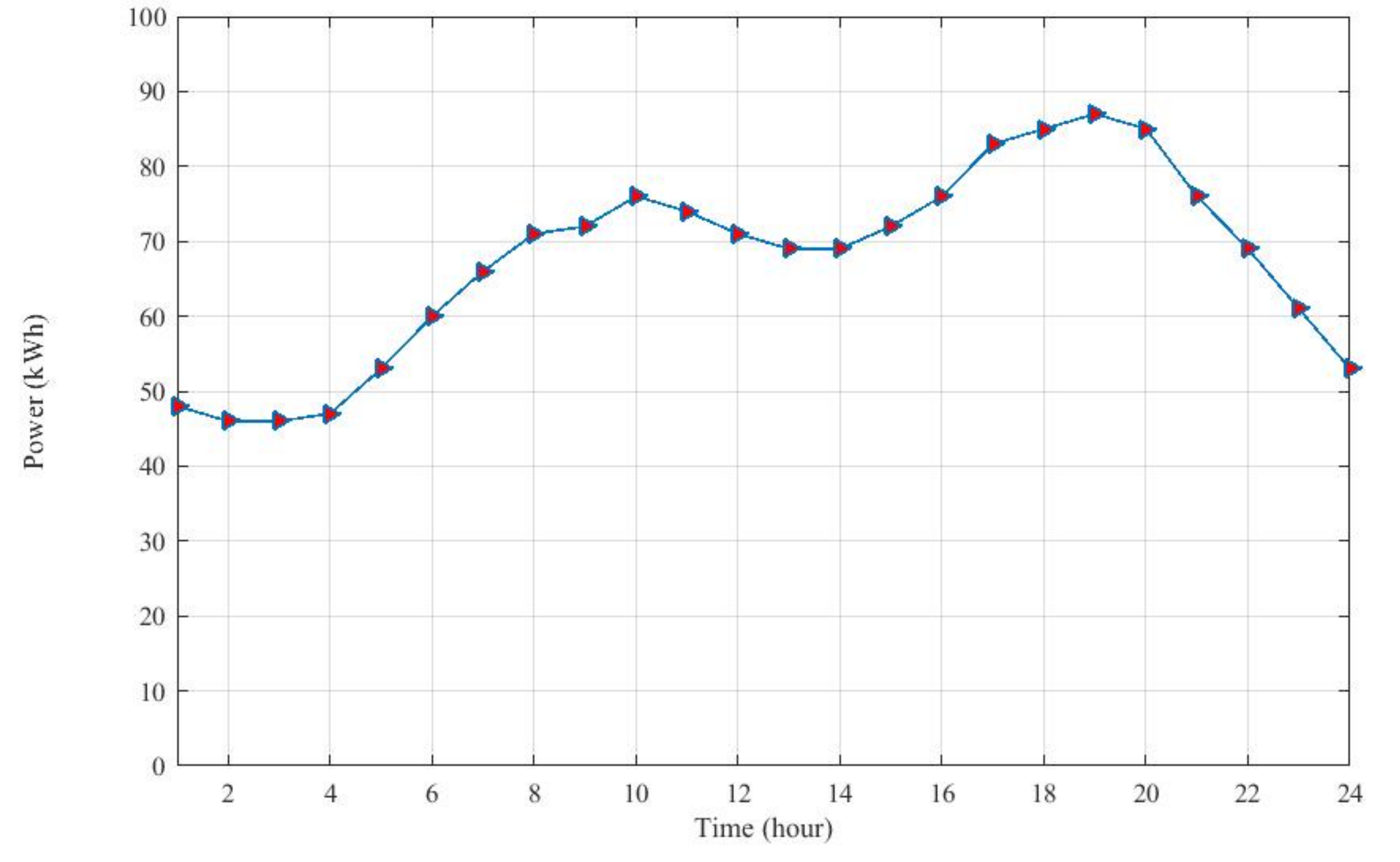
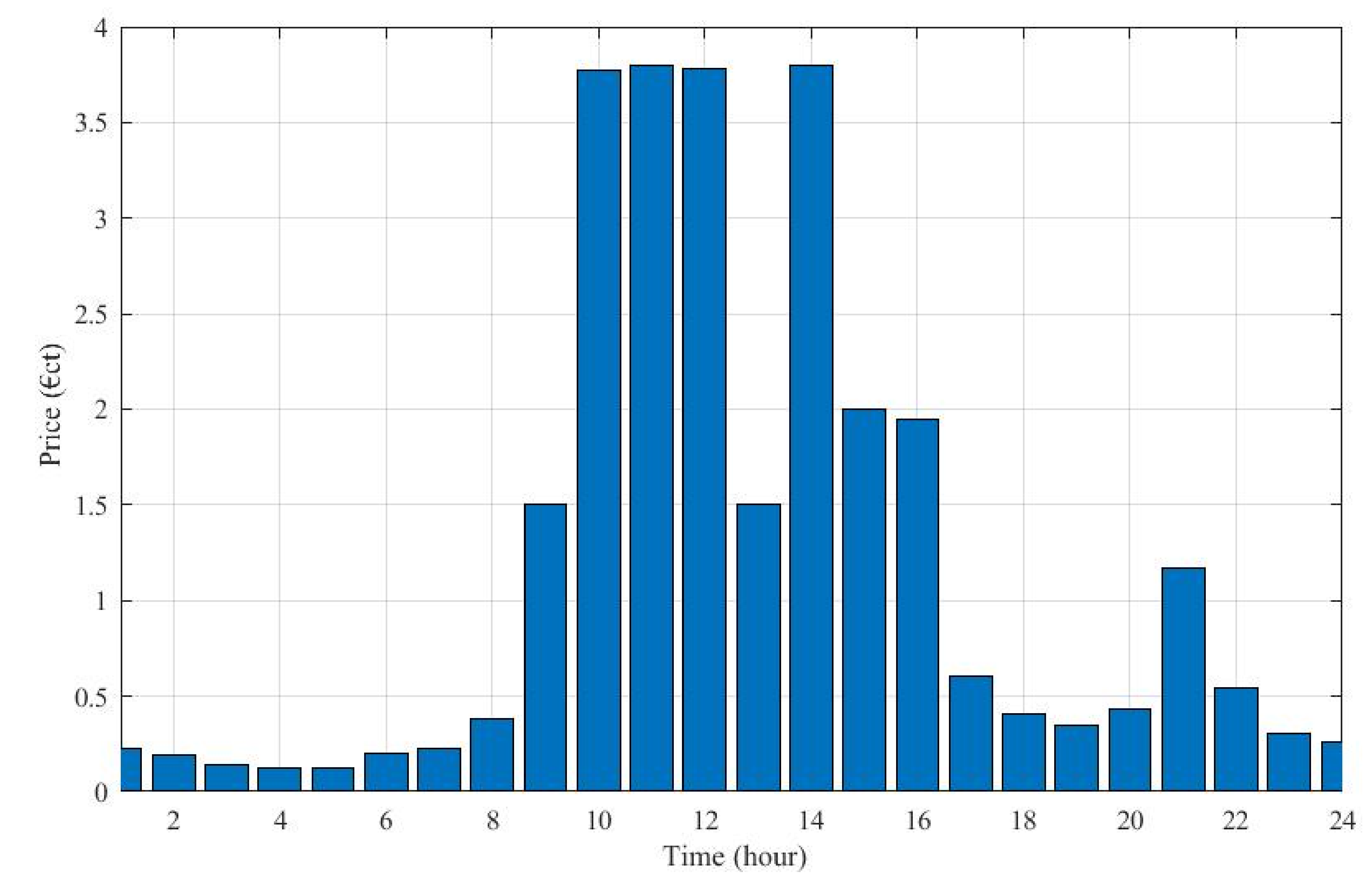

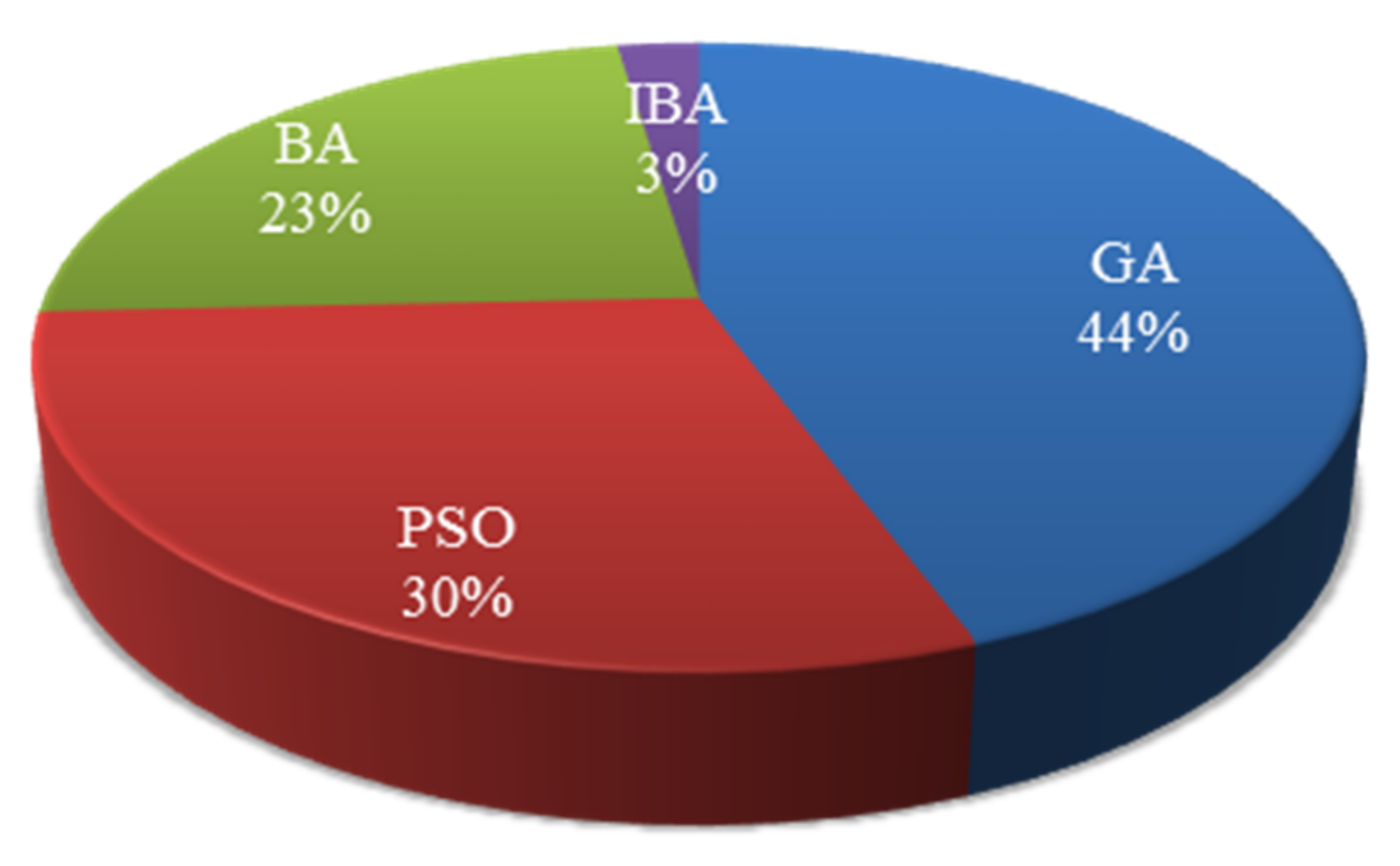


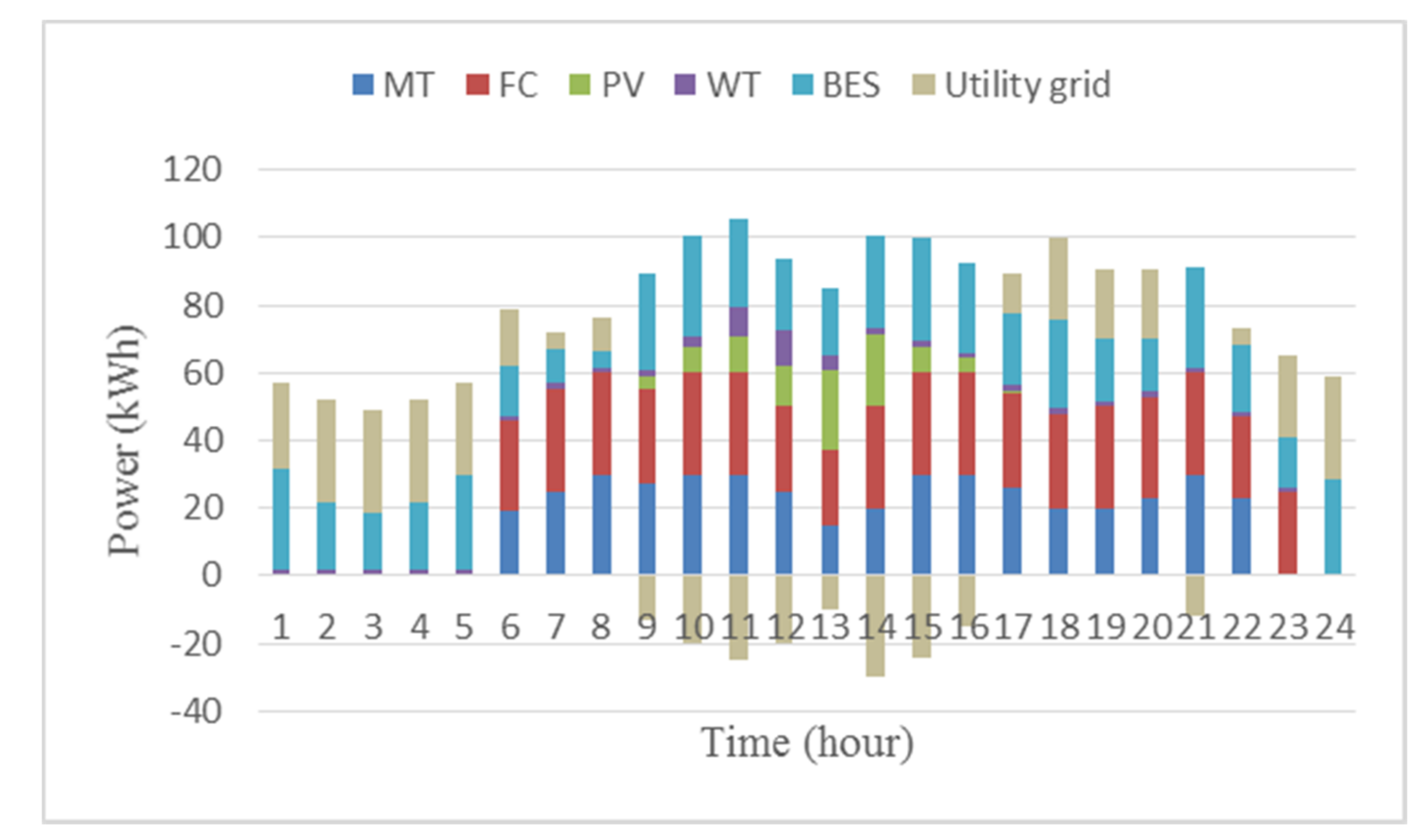
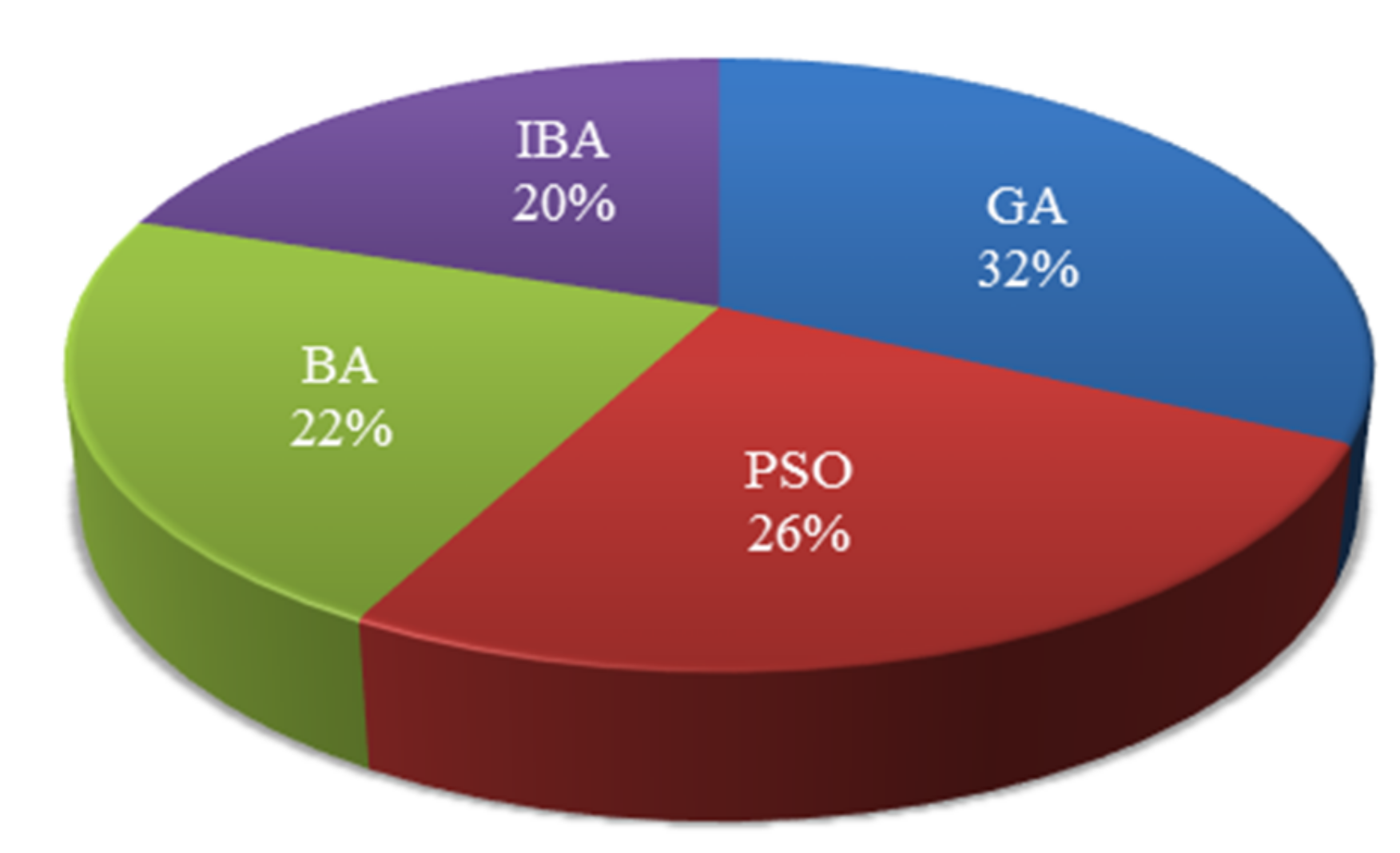
| Time (hour) | MT | FC | PV | WT | Utility Grid |
|---|---|---|---|---|---|
| 1 | 0 | 1 | 0 | 1 | 1 |
| 2 | 0 | 1 | 0 | 1 | 1 |
| 3 | 0 | 1 | 0 | 1 | 1 |
| 4 | 1 | 1 | 0 | 1 | 1 |
| 5 | 1 | 1 | 0 | 1 | 1 |
| 6 | 1 | 1 | 0 | 1 | 1 |
| 7 | 1 | 1 | 0 | 1 | 1 |
| 8 | 1 | 1 | 1 | 1 | 1 |
| 9 | 1 | 1 | 1 | 1 | 1 |
| 10 | 1 | 1 | 1 | 1 | 1 |
| 11 | 1 | 1 | 1 | 1 | 0 |
| 12 | 1 | 1 | 1 | 1 | 0 |
| 13 | 1 | 1 | 1 | 1 | 0 |
| 14 | 1 | 1 | 1 | 1 | 0 |
| 15 | 1 | 1 | 1 | 1 | 1 |
| 16 | 1 | 1 | 1 | 1 | 1 |
| 17 | 1 | 1 | 1 | 1 | 1 |
| 18 | 1 | 1 | 0 | 1 | 1 |
| 19 | 1 | 1 | 0 | 1 | 1 |
| 20 | 1 | 1 | 0 | 1 | 1 |
| 21 | 1 | 1 | 0 | 1 | 1 |
| 22 | 1 | 1 | 0 | 1 | 1 |
| 23 | 1 | 1 | 0 | 1 | 1 |
| 24 | 1 | 1 | 0 | 1 | 1 |
| Methodology | Best operation Cost (€ct) | Mean Operation Cost (€ct) | Worst Operation Cost (€ct) |
|---|---|---|---|
| GA | 1041.8376 | 1196.3251 | 1361.2437 |
| PSO | 968.0190 | 1081.8351 | 1241.7459 |
| BA | 933.8145 | 989.3718 | 106.9860 |
| IBA | 825.8849 | 825.8849 | 825.8849 |
| GWO | 813.6850 | 815.5231 | 816.8512 |
| Time (hour) | Microturbine (MT) | Fuel Cell (FC) | Photovoltaic (PV) | Wind Turbine (WT) | Battery-Energy Storage (BES) | Utility Grid |
|---|---|---|---|---|---|---|
| 1 | 1 | 1 | 0 | 1 | 1 | 1 |
| 2 | 1 | 1 | 0 | 1 | 1 | 1 |
| 3 | 1 | 1 | 0 | 1 | 1 | 1 |
| 4 | 1 | 1 | 0 | 1 | 1 | 1 |
| 5 | 1 | 1 | 0 | 1 | 1 | 1 |
| 6 | 1 | 1 | 0 | 1 | 1 | 1 |
| 7 | 1 | 1 | 0 | 1 | 1 | 1 |
| 8 | 1 | 1 | 1 | 1 | 1 | 1 |
| 9 | 1 | 1 | 1 | 1 | 1 | 1 |
| 10 | 1 | 1 | 1 | 1 | 1 | 1 |
| 11 | 1 | 1 | 1 | 1 | 1 | 1 |
| 12 | 1 | 1 | 1 | 1 | 1 | 1 |
| 13 | 1 | 1 | 1 | 1 | 1 | 1 |
| 14 | 1 | 1 | 1 | 1 | 1 | 1 |
| 15 | 1 | 1 | 1 | 1 | 1 | 1 |
| 16 | 1 | 1 | 1 | 1 | 1 | 1 |
| 17 | 1 | 1 | 1 | 1 | 1 | 1 |
| 18 | 1 | 1 | 0 | 1 | 1 | 1 |
| 19 | 1 | 1 | 0 | 1 | 1 | 1 |
| 20 | 1 | 1 | 0 | 1 | 1 | 1 |
| 21 | 1 | 1 | 0 | 1 | 1 | 1 |
| 22 | 1 | 1 | 0 | 1 | 1 | 1 |
| 23 | 1 | 1 | 0 | 1 | 1 | 1 |
| 24 | 1 | 1 | 0 | 1 | 1 | 1 |
| Methodology | Best Operation Cost (€ct) | Mean Operation Cost (€ct) | Worst operation Cost (€ct) |
|---|---|---|---|
| GA | 615.9034 | 623.4835 | 638.6436 |
| PSO | 567.5185 | 575.1266 | 592.8787 |
| BA | 520.2354 | 532.1278 | 550.6589 |
| IBA | 497.0082 | - | - |
| GWO | 445.3254 | 450.6587 | 465.2154 |
| Time (hour) | MT | FC | PV | WT | BES | Utility Grid |
|---|---|---|---|---|---|---|
| 1 | 0 | 0 | 0 | 1 | 1 | 1 |
| 2 | 0 | 0 | 0 | 1 | 1 | 1 |
| 3 | 0 | 0 | 0 | 1 | 1 | 1 |
| 4 | 0 | 0 | 0 | 1 | 1 | 1 |
| 5 | 0 | 0 | 0 | 1 | 1 | 1 |
| 6 | 1 | 1 | 0 | 1 | 1 | 1 |
| 7 | 1 | 1 | 0 | 1 | 1 | 1 |
| 8 | 1 | 1 | 1 | 1 | 1 | 1 |
| 9 | 1 | 1 | 1 | 1 | 1 | 1 |
| 10 | 1 | 1 | 1 | 1 | 1 | 1 |
| 11 | 1 | 1 | 1 | 1 | 1 | 1 |
| 12 | 1 | 1 | 1 | 1 | 1 | 1 |
| 13 | 1 | 1 | 1 | 1 | 1 | 1 |
| 14 | 1 | 1 | 1 | 1 | 1 | 1 |
| 15 | 1 | 1 | 1 | 1 | 1 | 1 |
| 16 | 1 | 1 | 1 | 1 | 1 | 1 |
| 17 | 1 | 1 | 1 | 1 | 1 | 1 |
| 18 | 1 | 1 | 0 | 1 | 1 | 1 |
| 19 | 1 | 1 | 0 | 1 | 1 | 1 |
| 20 | 1 | 1 | 0 | 1 | 1 | 1 |
| 21 | 1 | 1 | 0 | 1 | 1 | 1 |
| 22 | 1 | 1 | 0 | 1 | 1 | 1 |
| 23 | 0 | 1 | 0 | 1 | 1 | 1 |
| 24 | 0 | 0 | 0 | 1 | 1 | 1 |
| Methodology | Best Operation Cost (€ct) | Mean Operation Cost (€ct) | Worst Operation Cost (€ct) |
|---|---|---|---|
| GA | 499.0665 | 506.4029 | 523.5212 |
| PSO | 459.8236 | 466.6086 | 485.2675 |
| BA | 436.7845 | 446.3267 | 456.2547 |
| IBA | 424.1339 | - | - |
| GWO | 297.5429 | 299.3274 | 312.8742 |
© 2018 by the authors. Licensee MDPI, Basel, Switzerland. This article is an open access article distributed under the terms and conditions of the Creative Commons Attribution (CC BY) license (http://creativecommons.org/licenses/by/4.0/).
Share and Cite
Nimma, K.S.; Al-Falahi, M.D.A.; Nguyen, H.D.; Jayasinghe, S.D.G.; Mahmoud, T.S.; Negnevitsky, M. Grey Wolf Optimization-Based Optimum Energy-Management and Battery-Sizing Method for Grid-Connected Microgrids. Energies 2018, 11, 847. https://doi.org/10.3390/en11040847
Nimma KS, Al-Falahi MDA, Nguyen HD, Jayasinghe SDG, Mahmoud TS, Negnevitsky M. Grey Wolf Optimization-Based Optimum Energy-Management and Battery-Sizing Method for Grid-Connected Microgrids. Energies. 2018; 11(4):847. https://doi.org/10.3390/en11040847
Chicago/Turabian StyleNimma, Kutaiba Sabah, Monaaf D. A. Al-Falahi, Hung Duc Nguyen, S. D. G. Jayasinghe, Thair S. Mahmoud, and Michael Negnevitsky. 2018. "Grey Wolf Optimization-Based Optimum Energy-Management and Battery-Sizing Method for Grid-Connected Microgrids" Energies 11, no. 4: 847. https://doi.org/10.3390/en11040847
APA StyleNimma, K. S., Al-Falahi, M. D. A., Nguyen, H. D., Jayasinghe, S. D. G., Mahmoud, T. S., & Negnevitsky, M. (2018). Grey Wolf Optimization-Based Optimum Energy-Management and Battery-Sizing Method for Grid-Connected Microgrids. Energies, 11(4), 847. https://doi.org/10.3390/en11040847







